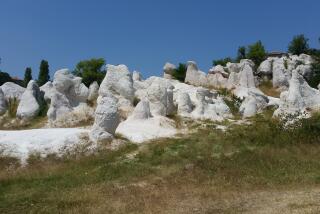The irrational fear of our state rock
Let’s set aside the charge that a state legislator could spend her time more wisely than promoting a law to drop the state rock (from statedom, not the top of her opponent).
Let’s also set aside the fact that it would surprise absolutely no one if we were to learn that state Sen. Gloria Romero (D-Los Angeles), who has proposed dropping serpentine as the state rock of California because it contains asbestos fibers, is getting campaign contributions from asbestos activists or plaintiffs’ attorneys, which she’s denied.
Let’s just focus on how silly it is that the idea is getting support. Not silly to the Californian woman who proposed the idea a couple years ago, after her husband died of asbestos-caused lung cancer. But it is patently silly that the understandable emotions of a few get magnified into such extremes as this.
And this is only one example. Society does this all the time, building the worries of a minority into the fear-driven policies of the many. Sometimes this occurs at our peril, so it’s worth deconstructing the serpentine dustup for the lessons it can teach.
Asbestos has a deservedly dark reputation. Inhaled, its long fibers, which don’t break down in the chemical soup of our body, cause mesothelioma, lung cancer and other lung disorders — which we learned after it was used as a fire retardant in ship construction and shipbuilders started getting those specific lung diseases at several times the rate of the average population. Not only that: The fat cats selling the stuff knew asbestos was dangerous long ago, and said nothing, as they filled their wallets. That dirty laundry only came out when shipbuilders and their survivors started to sue.
So — and rightly so — asbestos has been stigmatized, as sociologists and psychologists would say. The word “asbestos” evokes all sorts of negative feelings. It’s like “chemicals” or “nuclear waste.” Those words automatically trigger strong feelings. Negative feelings. Danger is built into the meaning of the words themselves.
And when it comes to words whose meaning is associated with danger, the memory of that meaning actually resides in the part of the brain called the amygdala, the clump of specialized cells down near the brain stem where fear begins, instinctively, subconsciously, before the reasoning, rational part of the brain even has a chance to chime in. To keep us alive, the amygdala is set on a hair-trigger and sets off a fear response the instant a potentially threatening stimulus comes in.
So when you say, “Asbestos probably saved tens of thousands of lives by preventing fires on ships,” or “Nuclear waste does far less health damage than the air pollution from burning fossil fuels,” the animal instinct to stay alive kicks in when you hear “asbestos” and “nuclear waste,” and before the other words are even spoken, your amygdala is basically telling you to beware. Not the most rational way to think things through, but remember, this system of risk perception evolved to keep us alive, not to help us get straight A’s in class.
Then another problem arises, something the academics call social amplification. The fear first/think second response builds on itself, as you tell a friend, “Hey, did you hear our state rock has asbestos?!” and the friend tells some more friends, and then the news media scream and yell, and victims show up and demand justice, and the lies of the industry come out and trust is destroyed. All sorts of secondary and tertiary inputs, which have nothing to do with the scientific facts of the risk of asbestos, amplify the fear.
Afraid, we demand that something be done. So laws are passed and investigations are conducted and money is devoted to “the problem,” even though sometimes the problem is that we’re scared, not that we’re actually at risk. The pretty green serpentine rock on the ground in California (more in Central and Northern California than most other states because of local tectonics, thus its official status) isn’t going to hurt anybody, unless they pick it up and grind it into powder and inhale the dust, which is true of a lot of rocks. (Not like the California state flower, the poppy, or the California state mammal, the grizzly bear! Or the New Hampshire and North Carolina state rock, granite, which contains radioactive uranium. Or the state rock of Kentucky, West Virginia and Utah — coal!)
Fear is a wonderful thing. It keeps us alive. But it also can lead us to do silly things and spend money and time and other precious resources in silly and inefficient ways, protecting ourselves from what we fear more than from what actually threatens us.
Which in the end leaves us at greater risk. So the serpentine fuss is a teachable moment. Maybe Romero’s constituents could ask her to propose a law to outlaw dumb laws that make us feel safe but do nothing to actually protect us.
David Ropeik is an instructor at Harvard University and the author of “How Risky Is It, Really? Why Our Fears Don’t Always Match the Facts.”
More to Read
Get the L.A. Times Politics newsletter
Deeply reported insights into legislation, politics and policy from Sacramento, Washington and beyond. In your inbox three times per week.
You may occasionally receive promotional content from the Los Angeles Times.










